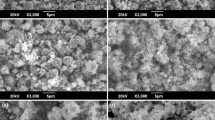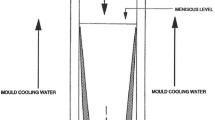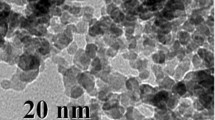Abstract
General aspects (including terminology) related to the use of ultradisperse particulates (nanosystems) are discussed. The important role of nanoparticles in the technology of highly concentrated binding suspensions (HCBS) and refractory castables is emphasized. Using nanoparticles provides a route toward improving the rheotechnologic properties of HCBS and HCBS-based molding mixtures as well as the structure and service properties of the end product.
Similar content being viewed by others
REFERENCES
Yu. E. Pivinskii, "Stabilization and aging of ceramic suspensions," Ogneupory, No. 8, 15-22 (1983).
Yu. E. Pivinskii, F. S. Kaplan, S. G. Semikova, and M. A. Trubitsyn, ""Highly concentrated ceramic binding suspensions. Colloidal component and binding properties," Ogneupory, No. 2, 13-18 (1989).
Yu. E. Pivinskii, "Highly concentrated ceramic binding suspensions. Dispersion composition and casing porosity," Ogneupory, No. 4, 17-23 (1989).
Yu. E. Pivinskii, Ceramics Binders and Ceramic Castables [in Russian], Metallurgiya, Moscow (1990).
Yu. E. Pivinskii, Theoretical Aspects of the Technology of Ceramics and Refractories. Selected Works, Vol. 1 [in Russian], Stroiizdat, St. Petersburg (2003).
B. Ostwald, The World of Ignored Dimensions. An Introduction to Modern Colloid chemistry and a Review of Its Applications [Russian translation], Mir, Moscow (1923).
Yu. I. Petrov, The Physics of Small Particles [in Russian], Nauka, Moscow (1982).
I. D. Morokhov, L. I. Trusov, and V. N. Lapovok, Physical Effects in Ultradisperse Media [in Russian], fnergoatomizdat, Moscow (1984).
"Physical chemistry of ultradisperse systems," in: Proceedings of the 4th All-Russia Research Conference [in Russian], Moscow Institute of Engineering Physics (MIFI), Moscow (1999).
B. M. Summ and N. I. Ivanova, "Colloid chemistry in nanochemistry: objects and methods," Usp. Khim., 69(11), 995-1008 (2000).
A. I. Gusev and A. A. Rempel, Nanocrystalline Materials [in Russian], Fizmatlit, Moscow (2001).
I. V. Melikhov, "Physical chemistry of nanosystems: achievements and problems," Vestn. Ross. Akad. Nauk, 72(10), 900-909 (2002).
"National initiative of the USA in the field of nanotechnologies," in: Glass and Ceramics XXI. Prospects for Development [in Russian], Yanus, St. Petersburg (2001), pp. 267-298.
Yu. E. Pivinskii and E. V. Rozhkov, "Ceramic castables: final stage in the evolution of low-cement refractory castables," Novye Ogneupory, No. 4, 24-31 (2002).
L. B. Khoroshavin and V. A. Perepelitsyn, "The refractory nanotechnology," Ogneup. Tekh. Keram., No. 12, 30-35 (1999).
Yu. E. Pivinskii, Refractories in the 21st Century [in Russian], BelGASM, Belgorod (1999).
Yu. E. Pivinskii, Unshaped Refractories. Book 1. General Technology [in Russian], Nauka, Moscow (1972).
G. S. Khodakov, Physics of Grinding [in Russian], Nauka, Moscow (1972).
A. V. Belyakov and V. N. Sigaev, Physical Chemistry of the Mechanical Grinding of Inorganic Materials [in Russian], D. I. Mendeleev Russian Chemical Engineering University, Moscow (2001).
N. I. Gorbunov, Soil Colloids [in Russian], Izd. AN SSSR, Moscow (1975).
Yu. E. Pivinskii and M. A. Trubitsyn, "Highly concentrated ceramic binding suspensions. Dispersion Medium. Stabilization and Binding Properties," Ogneupory, No. 12, 9-14 (1987).
R. Iler, Chemistry of Silica, John Wiley & Sons, New York (1979).
Yu. E. Pivinskii and Dobrodon, "Preparation and properties of binding high-alumina suspensions in the bauxite-quartz glass system," Novye Ogneupory, No. 5, 19-26 (2002).
Z. Xinwer, J. Dongliang, T. Souhong, et al., "A study of powdered aluminum oxide in silica gel," J. Chin. Ceram. Soc., 29(3), 263-266 (2001).
M. X. Fisher, M. Colic, M. P. Rao, and F. E. Zange, "Effect of silica nanoparticle size on the stability of alumina - silica suspensions," J. Am. Ceram. Soc. 84(10), 713 (2001).
S. Banerjee, "Recent developments in monolithic refractories," Am. Ceram. Soc. Bull., No. 10, 59-63 (1998).
Author information
Authors and Affiliations
Rights and permissions
About this article
Cite this article
Pivinskii, Y.E., Dyakin, P.V., Pivinskii, Y.Y. et al. Nanoparticles and Their Effective Use in the Technology of Highly Concentrated Binding Suspensions (HCBS) and Refractory Castables. Part 1. Refractories and Industrial Ceramics 44, 309–313 (2003). https://doi.org/10.1023/B:REFR.0000009037.47738.85
Issue Date:
DOI: https://doi.org/10.1023/B:REFR.0000009037.47738.85




